Mt Everest is witness to cock and bull stories of bravado, like the one told by the Rathods of Pune about their fake climb. Lax rules are encouraging ill-prepared climbers to join a hollow race to the top
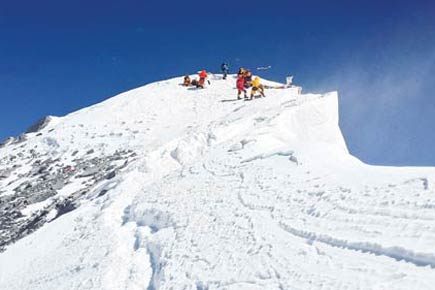
At 8,848 metres and with temperatures that touch -19º Celsius in summer, the summit of Mount Everest continues to captivate people all over the world. While once only serious mountaineers ventured over the world’s highest mountain, today, bankers, doctors, lawyers and students are among those attempting to climb it for the fame and accolades that follow.
ADVERTISEMENT
Also read: Himalayan con? Probe ordered into Pune couple's Everest record
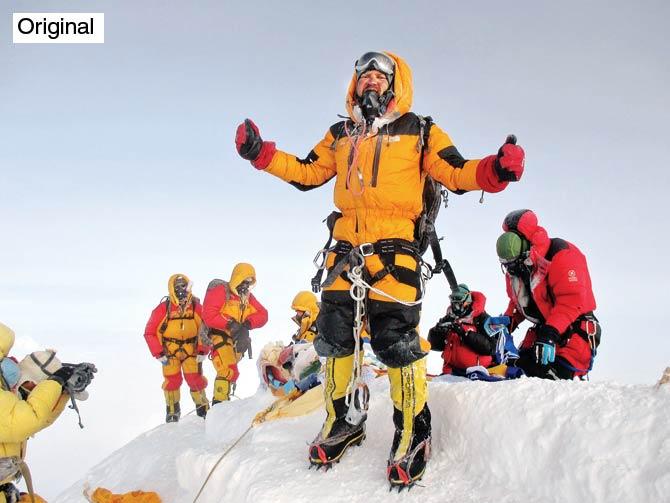
Bengaluru mountaineer Satyarup Siddhanta exults after summiting Everest on May 21, 2016
That, fellow mountaineers say, is probably what led the constable couple from Pune — Dinesh and Tarakeshwari Rathod — to fake their feat. The lure of fame and its attendant perks. The Rathods are in the news for morphing photographs of having reached the summit of Mount Everest on May 23 this year. The couple was covered in mainstream press with fanfare, and even felicitated by the Pune police commissioner. Emerging evidence points out that they may not have even got past the Everest base camp. A police inquiry is currently underway. Tarakeshwari refused to comment.
Also read: Pune constable couple morphed my Everest pictures: Bengaluru climber
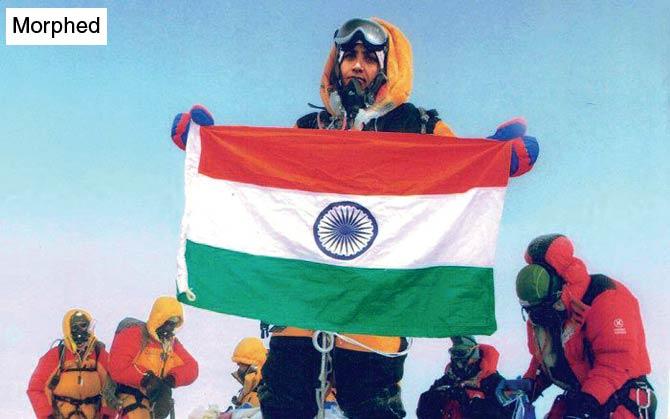
In this photo, allegedly morphed from the original one featuring Siddhanta, Tarakeshwari Rathod holds the Indian flag. The climbers in the background are in the same position as in Siddhanta’s photo
Alan Arnette, a renowned mountaineer and professional speaker based out of Colarado, runs a blog that’s a must-read for every serious climber. He says, “To state the obvious, Everest is the highest peak on Earth and is a dream for many climbers. While not the hardest climb, nor the most technical, an Everest summit brings bragging rights and great personal gain.”
Also read: Himalayan Con: Nepal tourism department admits to goof-up in certification process
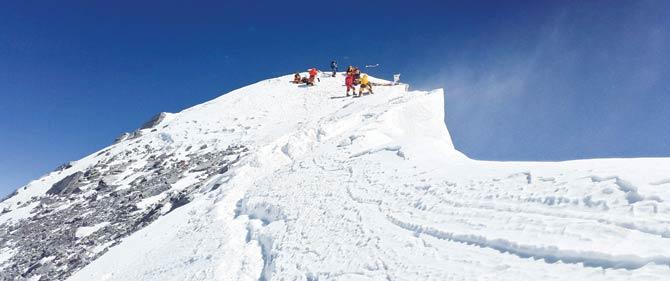
Faking? It’s common!
Bachendri Pal, the first Indian woman mountaineer to get to the top of the world in 1984, says mountaineering history is littered with such instances of fake feats, but most go unreported. For instance, the case of the two Indian climbers from a northern state, who claimed to have reached the summit on May 20 this year. They received a certificate for their feat, but mountaineers who were at the summit that day, say these two climbers were not on the mountain. There has, however, been no police complaint filed in this case.
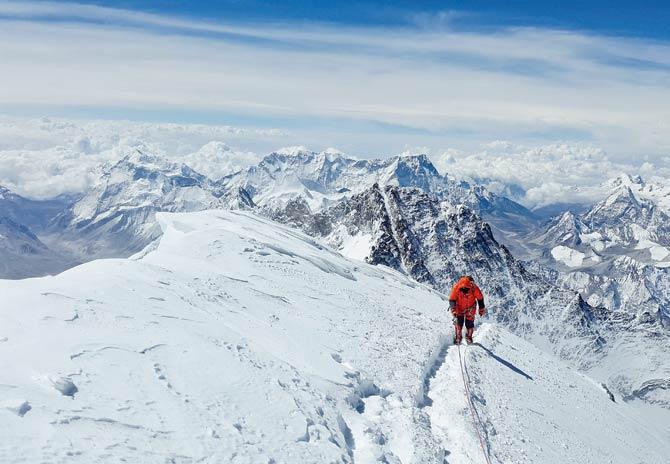 Mt Everest Summit. Pic/Mingma Tenji Sherpa
Mt Everest Summit. Pic/Mingma Tenji Sherpa
And, it is not just Indians who fake it. Arnette recounts the case of a climb on K2, the world’s second highest peak located on the Pakistan-Chinese border. Christian Stangl, an Austrian, had claimed the only K2 ascent during the pre-monsoon season in August 2010. The alpinist (mountaineer in the Alps) even talked about a 70-hour solo rush to the summit and back. The news made headlines on almost all specialised websites, also because the summit had been the only K2 top that year. On September 12, 2010, Stangl admitted on Austrian television that he did not reach the summit of K2. He said he had simulated the ascent in a ‘state of coma caused by stress and the fear of failure’.
According to Arnette, the accolades that follow such feats are huge. “The need for admiration drives the ego and thus the false claims. Finally, in some countries, a person who has reached the Everest summit is rewarded with both publicity from the media and financially from sponsors as well as employment opportunities and hence will do almost anything to claim a summit,” he said.
Rules, but no one follows them
A Sherpa from a reputable agency that organises Mt Everest expeditions every year, says, “While there are rules, there are no checks in place. Everything is based on trust and taken at face value.” That is probably one of the reasons the Rathods and other climbers have got away with faking records. As long as nobody complains, the truth never emerges.
For instance, the Sherpa said, the certificate of successful climbing is issued after the expedition leader, the expedition-operating company, the Sherpa guides and the liaison officer attest that the climber or climbers made it to the summit.
In the case of the Rathods, the climbing community found it strange that Nepal’s tourism department officials were in such a hurry to issue the certificate without the formalities being completed. A picture of the climber at the summit as well as statements of the Sherpa guide or guides is also required for certification. With the Rathods, very clearly, the certificate was issued without the statements of the guides.
As per mountaineering regulations, the liaison officer submits a detailed report on expeditions and the tourism department records statements from expedition members as well as their climbing Sherpas to verify their claims. The tourism department gives summit certificates to the expedition members only after recording multiple statements and verifying all summit evidence.
The Rathods, accompanied by representatives of the Kathmandu-based agency that organised their climb — Makalu Adventures — submitted the photographs, while the liaison officer had filled a standard form as a formality.
Speaking about the Rathods, Tendi Sherpa, who has peaked the Everest 10 times, says, “I reached the summit from the north (Tibet) side on May 23, 2016 [the same day the Rathods claimed to have reached the summit] and we did not see anybody from the Nepal side during the time we spent at the top.” He also says it is not possible that the Rathods reached the summit at 6.30 am. “We were at the peak on May 23 between 7 am and noon and did not see a single person coming from the south (Nepal) side.”
Tendi is a UIAGM (Union Internationale des Associations de Guides de Montagnes) certified mountain guide. UIAGM is the highest certification for mountain guiding that stresses on all aspects of guiding such as communication, technical skills, decision making, alertness on the mountains and above all safety on the mountains.
“If Nepal is lax, so is Tibet. There, all the climber has to say is that he has reached the summit and a certificate is happily given,” says Tendi.
According to him, “There have to be stricter rules in place and each climber should have a 360-degree video without a pause along with their face and maybe their team while at the summit.” Arnette says if Nepal required previous summit proof of an 8,000-metre mountain before issuing an Everest permit, the cases of fraud could go down. Nepal would still benefit as seven of the 14 mountains above 8,000 metres are in that country.
Why do adventure agencies back this fraud?
Is it the lure of more business because of higher ratings? Arnette says, “Many agencies advertise their number of Everest summits as proof of their expertise. So, the more summits, the more clients they can attract. While the vast majority of sherpas are ethical, it is reasonable to assume one or two may not go against the false claim of a client as he has paid them a lot of money.”
He says, “The rules state that the Nepal Ministry of Tourism has to ask for a summit picture of the climber with his feet on the snow on the summit and his face fully showing (not covered by a mask). There should also be a clear view of the background. But, it is safe to assume these rules are loosely followed and the ministry takes the word of the expedition leader as proof.”
'Impossible that Rathods climbed'
Armyman Col Ranveer Jamwal, who has been leading Army Expeditions to Mt Everest since 2012, says, “It’s not only the climbers who should be blamed but the agency that organised their expedition, the sherpas who have lied and the Department of Tourism that has given out a certificate of summit based on lies and false photos.”
“Secondly, if the Rathod couple had reached base camp on May 10, then it is impossible that they could have climbed on May 23, 2016. The acclimatisation process takes at least a month. Also, I kept a track of all Indian climbers at the base camp. Between May 23 and 25 this year, there were only three climbers at Camp 2. If the Rathods reached the summit on May 23, we would have known,” Jamwal says. The reason Jamwal kept a track of all Indian climbers is because in the case of any eventuality he would know their whereabouts. All Everest expeditions are a 60-65 day process.
He says, “There should be strict rules and criteria for climbers. In the Army, we send 10-15 expeditions every year and there is a very tough selection process for being on the expedition team.”
— Inputs by Dharmendra Jore
 Subscribe today by clicking the link and stay updated with the latest news!" Click here!
Subscribe today by clicking the link and stay updated with the latest news!" Click here!





_d.jpg)

